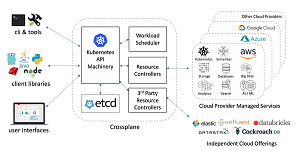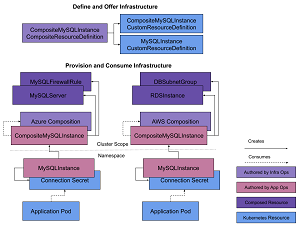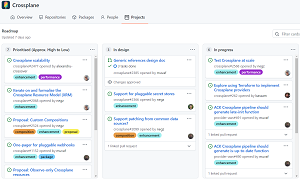News
CNCF Incubates Kubernetes Add-on 'Crossplane,' a Universal Control Plane
The Cloud Native Computing Foundation (CNCF) is now incubating Crossplane, an open source project providing a Kubernetes add-on that acts as a universal control plane with which enterprises can consume infrastructure.
The Crossplane web site says it's used to compose cloud infrastructure and services into custom platform APIs. Specifically, it "enables platform teams to assemble infrastructure from multiple vendors, and expose higher level self-service APIs for application teams to consume. Crossplane effectively enables platform teams to quickly put together their own opinionated platform declaratively without having to write any code, and offer it to their application teams as a self-service Kubernetes-style declarative API."
In effect, the open source project extends the Kubernetes API in order to manage and compose infrastructure. It provides Kubernetes CRDs (custom resource definitions) for any infrastructure or managed service, which can be composed into higher-level abstractions that can be versioned, managed, deployed and consumed with existing Kubernetes cluster-integrated tools and processes. It works with all the big cloud platforms, AWS, Microsoft Azure, Google Cloud, Alibaba Cloud and so on.
 [Click on image for larger view.] Crossplane Architecture (from 2018 post) (source: Crossplane).
[Click on image for larger view.] Crossplane Architecture (from 2018 post) (source: Crossplane).
"With Crossplane, platform teams easily compose their own opinionated cloud APIs without having to write any code," the CNCF said in a Sept. 14 post. "Operators then offer it to their application teams as a self-service Kubernetes-style declarative API. Infrastructure provisioned through Crossplane is continuously reconciled, simplifying day 2 operations and eliminating configuration drift."
 [Click on image for larger view.] Crossplane Composition (source: Crossplane).
[Click on image for larger view.] Crossplane Composition (source: Crossplane).
The company Upbound created the project in 2018 and it was accepted as a Sandbox project by the CNCF before being accepted as an Incubating project. The next step is Graduation.
"We've seen impressive growth in the community statistics, indicating greater adoption and a growing ecosystem of people getting involved with the project," Crossplane said in its own post this week. "Many stats have increased by at least 50 percent in the last 9 months since being accepted into Sandbox, such as the number of GitHub stars (~2,000 to 3,680+) and commits to the project (~2,000 to 3,430+). Other metrics have seen greater relative increases, such as container downloads (13x), Slack members (4x), and contributors (3x). More than 100 different companies have now contributed code to Crossplane!"
Contributors are vital for such projects, of course, and Crossplane said it was excited about non-trivial feature contributions from the greater community, indicating a more serious adoption and commitment from community developers.
Crossplane is already out in maintained versions for production use, debuting in version 1.2 in April and advancing to v1.4 last month, and is being used by many organizations.
"Crossplane provides an open and extensible approach to building providers for different clouds," the CNCF quoted Paolo Dettori, senior technical staff member of IBM research, as saying. "IBM sees great value in the open ecosystem Crossplane has enabled by extending the Kubernetes control plane to manage external resources and on the power of custom compositions for building developer-friendly resource abstractions."
 [Click on image for larger view.] Crossplane Roadmap (source: Crossplane).
[Click on image for larger view.] Crossplane Roadmap (source: Crossplane).
The Crossplane roadmap shows some 16 different development efforts, focusing on scalability, testing and more, as shown in the partial graphic above. Following an eight-week cadence, the next release is set for Oct. 26.
About the Author
David Ramel is an editor and writer at Converge 360.